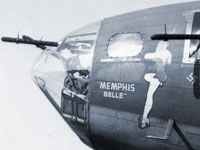The Memphis Belle
Question

I'm doing research on the movie Memphis Belle and how historically accurate it is. Can you tell me what the Memphis Belle’s last mission was, because I keep finding conflicting information about it.
Answer
The Memphis Belle was the nickname of a U.S. Army Air Force Boeing B-17F that flew strategic bombing missions from England into continental Europe. As part of the 324th Bomb Squadron of the 91st Bomb Group, the plane flew 25 operational missions between November 1942 and May 1943, returning from all missions with its crew intact.
Most of the plane’s missions were flown by the same crew, but a few were not. Conversely, the plane’s usual crew, headed by Captain Robert K. Morgan, flew several missions in other B-17s. According to the 324th Bomber Squadron mission reports, the plane’s usual crew flew their 25th mission on May 17th, 1943, piloting the Memphis Belle to the Keroman submarine base, located in the Breton city of Lorient. There they bombed a platform used to pull U-boats out of the water. However, the aircraft itself did not complete its 25th mission until its next flight. That flight, manned by a different crew than its usual one, occurred on May 19th and sent the Memphis Belle to the Kilian submarine pen and bunker at Kiel, Germany. Its mission was to bomb an engineering and turbine engine workshop.
So, the 25th mission of the crew occurred two days before the 25th mission of the aircraft, which may account for some of the confusion about the “last mission.” After both crew and plane completed their respective 25th mission, the crew received the Air Medal with three Oak Leaf Clusters and the Distinguished Flying Cross. They were then ordered in June to fly the Memphis Belle back to the United States for a cross-country tour, the aim of which was to increase morale back home and to sell War Bonds.
The commanders who directed the bombing raids on Europe had decided to limit a crew’s tour of duty to 25 missions in order to increase morale among the crews: Casualty rates at the beginning of the missions approached 80% and when the Memphis Belle completed its tour (the first heavy bomber to do so), it was a joyful event, not only for the crew, but also for the entire air command and the American public.
To mark the event, American filmmaker William Wyler (then a Major in the U.S. Army Air Force) filmed and produced a 1944 documentary for the War Department entitled Memphis Belle: A Story of a Flying Fortress. In 1990, Wyler’s daughter Catherine produced a fictionalized movie of the plane’s 25th operational mission, entitled Memphis Belle.
For more information
Life. "WWII: Allied bombers and Crews." 2011. Slideshow featuring photos from World War II.
Wyler, William. "Memphis Belle: A Story of a Flying Fortress". First Motion Picture Unit of the U.S. Army Air Corps. Paramount Pictures, Inc. 1944. Found in the right-hand navigation bar of WWII Reels.
U.S Air Force. "B-17 Flying Fortress." 2004.
Bibliography
91st Bomb Group. "Dailies of the 323rd Squadron." Accessed August 2011.
Richard G. Davis, Bombing the European Axis Powers. A Historical Digest of the Combined Bomber Offensive 1939–1945. Maxwell Air Force Base, AL: Air University Press, 2006.
